by Mary Bailey

One of the very best things about talking to people about their wine is that everyone has a different take. There are no hard and fast rules, no formulas, no recipes. Grant Stanley, Lake Country; Marcus Ansem, Naramata; Darryl Brooker, Kelowna and Jay Drysdale, Naramata, talk about wine and winemaking.
Marcus Ansems, Daydreamer Wines, Naramata
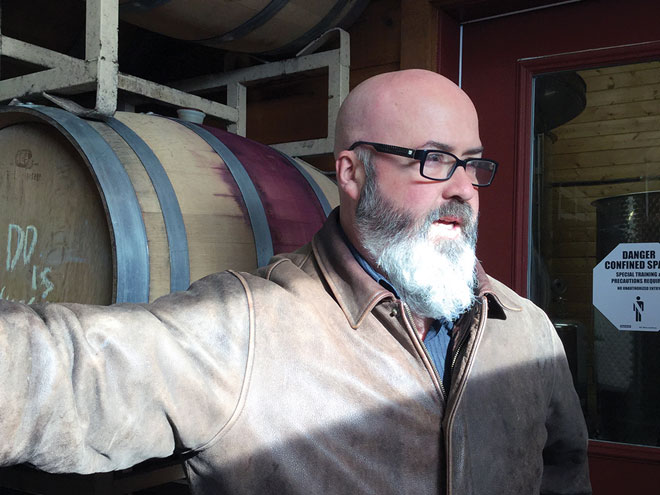
Australian Marcus Ansems has made wine in Ontario, Australia, Italy and South Africa; he is involved with the Hemispheres Wine Club; he was at Therapy Vineyards for several years. He not only has an Oenology degree from the University of Adelaide Roseworthy, he is Canada’s newest Master of Wine, winning two separate awards for excellence while doing so.
Smart, affable and makes delicious wine, which he names after his kids. What’s not to like?
“We just wanted to make the wine we wanted to drink,” he says about his newest project, Daydreamer Wines.
The Marcus Ansens Chardonnay is from a vineyard he and his wife Rachel lease near Kelowna. It’s 12 months in a French barrel “the more you spend on oak, the less you taste it,” he says. The wine has a lovely juicy minerality, superb acid balance and just a whisper of the oak.
“I have a love-hate relationship with Pinot in the valley,” he says, talking about the importance of selection. “The key to avoiding manipulation is to plant the right variety in the right spots.”
The Shiraz is a textbook example as to why people think Syrah holds such great promise in the Okanagan. It’s deliciously savoury, not jammy, with ripe tannins, forthright yet elegant.
Grant Stanley, 50th Parallel Estate Winery
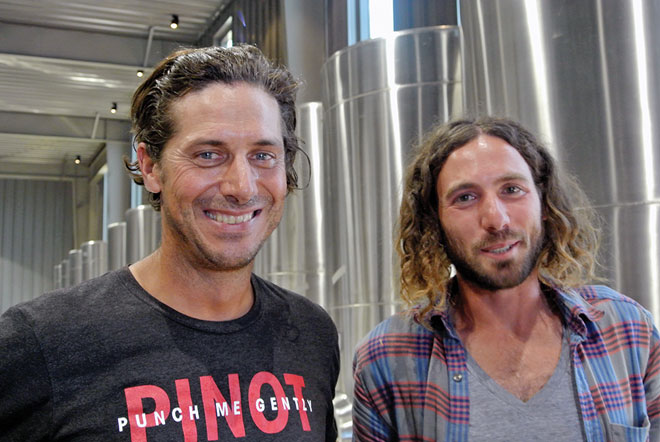
Grant Stanley is well known to lovers of British Columbia Pinot Noir, having made wine at Quails Gate Winery for 10 years. A few years ago he decamped north to Lake Country to be part of the new 50th Parallel.
“I like wood fermenters. We have some brand-spanking new 1-ton Pinot vats, French oak, coopered in Italy, lidded, with temperature control. We can ferment and age in them. They will last 20-30 years. The tannin exchange in wood vessels is nice, and the wines tend to be darker with a much nicer texture. I like the breathability, just enough oxygen. They’ve been using these in Oregon for a long time.
“Most people are using concrete for lees contact for Pinot Gris, Chenin and Sauvignon Blanc. I don’t. We pull off lees right away. It’s all in what you like. I don’t make whites in an oxidative style. I like super fresh and best in their youth. My whites are harvested in October and are ready to drink in April. The only wines in the cellar are Chardonnay and Pinot Noir.”
Talking to Grant is like taking a short course in wine chemistry. He explains the finer points of temperature control, the relationship between high acid and less sulphur and the science behind a spring malolactic fermentation for the reds.
“We have naturally cold winters. The wines are on gross less from November to March, which protects the wine and helps with colour and means more time without sulphur. When we warm up the barrels we don’t wait for the malo to start naturally. We inoculate because we want them to finish all at the same time.”
Darryl Brooker, Mission Hill, Cedar Creek Estate Wineries
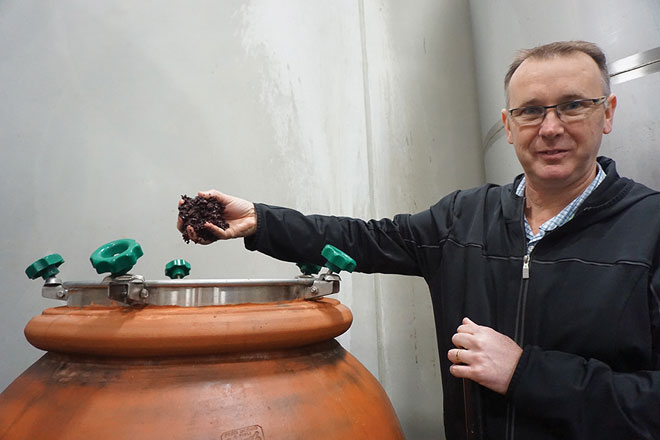
“I’m a huge fan of the concrete eggs,” says Darryl Brooker, referring to the fermentation vessel. “The wines are quite leesy, the wine is always moving in the vessel, you rarely need to sulphur.
“I bought my first at a trade show back in 2005, there were none in North America at that time. I’ve done several trials comparing eggs to stainless to oak. It’s all about the texture.”
We are here to see Darryl’s newest experiment, the Italian amphora. Into it went 2013 Cabernet Sauvignon grapes from the Desert Ridge Vineyard. The grapes were put in the amphora with nothing else; at eight months the wine was pressed by foot, then put into small stainless steel tanks.
“The thing about it is the breathability, lots of oxygen exchange, but not to be able to touch the wine, it was the hardest wine I ever made,” he says, “because you do nothing!”
The wine was delightful, fresh, with lots of interesting herbal notes, ripe and balanced tannins and a very attractive liveliness.
The 2014 Amphora project is a co-ferment of Desert Ridge Cabernet Sauvignon, Cabernet Franc and Merlot. Can’t wait.
Jay Drysdale, Bella Wines, Naramata
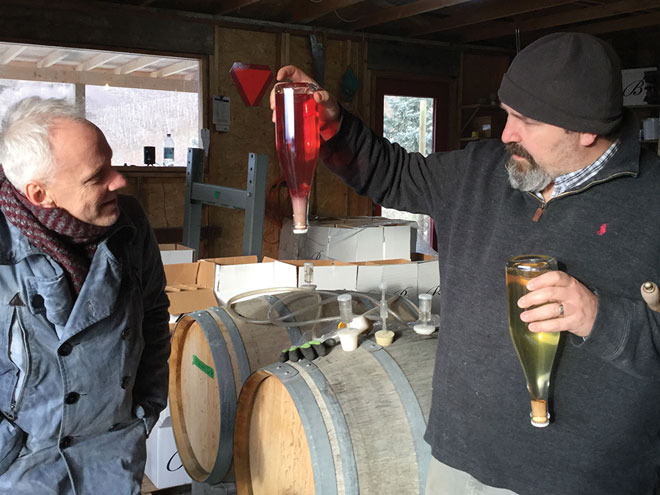
Jay Drysdale and his wife Wendy bought a small patch of land above Naramata in order to make sparkling wine.
It had a house, outbuildings, lots of grass and 20 small apple trees, which they took out and planted grapes instead. “We had second leaf in 2105,” says Jay.
I tasted Bella a few years back when visiting OK Crush Pad. At the time, someone was disgorging the wine by hand. Curious about this lo-fi sparkling wine project I called Jay to see about a visit.
We are escorted to the cellar/hamshack by Buddha, their newish bulldog. (The winery is named after Bella, their first bulldog, now sadly departed.)
“Vancouver Island is a perfect place for bubbles,” he says. “But it didn’t make sense with the ferries and the land here was cheaper.”
Their idea is to offer single vineyard sparkling wines made from Chardonnay and Gamay.
Not only are they making a traditional-method sparkling wine (modelled after Champagne, where a second fermentation happens in the bottle, capturing the CO2 which creates the fizz) they are also making a sparkling Gamay using the ancestral method (the Americans call this pét-nat, after petillant naturelle, the Italians, col fondo.)
They press into a barrel, then put the wine in the bottle with all of its lees, sediment and particulates. The wine finishes its first fermentation there producing small bubbles. It’s less bubbly than wine made in the traditional method, and won’t last as long, but the wine captures all the freshness and taste. They riddle and disgorge to remove most of the sediment, but without filtering, the wine is a bit cloudy, kind of like homemade beer. Old school and completely fun.
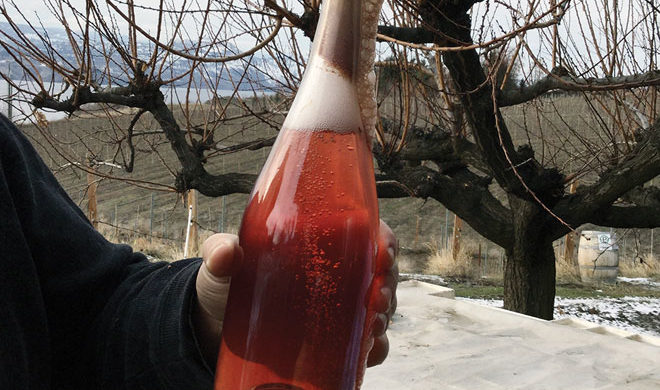
Very little wine is sold outside of BC so plan a stop there next time you are in the Okanagan. Bubbleheads will love the technical website.
Photos: Mary Bailey
The article was first published in 2016.